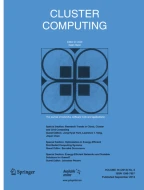Abstract
Load balancing is the significant task in the cloud computing because the cloud servers need to store avast amount of information which increases the load on the servers. The objective of the load balancing technique is that it maintains a trade-off on servers by distributing equal load with less power. Accordingly, this paper presents the load balancing technique based on the constraint measure. Initially, the capacity and load of each virtual machine are calculated. If the load of the virtual machine is greater than the balanced threshold value then,the load balancing algorithm is used for allocating the tasks. The load balancing algorithm calculates the deciding factor of each virtual machine and checks the load of the virtual machine. Then, it calculates the selection factor of each task. Then, the task which has better selection factor is allocated to the virtual machine. The performance of the proposed load balancing method is evaluated with the existing load balancing methods, such as HBB-LB, DLB, and HDLB for the evaluation metrics load and capacity. The experimental results show that the proposed method migrate only three tasks while the existing method HDLB migrates seven tasks.
Similar content being viewed by others
References
Chen, S.-L., Chen, Y.-Y., Kuo, S.-H.: CLB: a novel load balancing architecture and algorithm for cloud services. Comput. Electr. Eng. 56, 154–160 (2016)
Lawanyashri, M, Balusamy, B., Subha, S.: Energy-aware hybrid fruitfly optimization for load balancing in cloud environments for EHR applications. In: Informatics in Medicine Unlocked (2017)
Lin, C.-C., Chin, H.-H., Deng, D.-J.: Dynamic multiservice load balancing in cloud-based multimedia system. IEEE Syst. J. 8(1), 225–234 (2014)
Liu, Q., Cai, W., Shen, J., Liu, X., Linge, N.: An adaptive approach to better load balancing in a consumer-centric cloud environment. IEEE Trans. Consum. Electron. 62(3), 243–250 (2016)
Zhao, J., Yang, K., Wei, X., Ding, Y., Hu, L., Xu, G.: A heuristic clustering-based task deployment approach for load balancing using bayes theorem in cloud environment. IEEE Trans. Parallel Distrib. Syst. 27(2), 305–316 (2016)
Xu, G., Pang, J., Fu, X.: A load balancing model based on cloud partitioning for the public cloud. Tsinghua Sci. Technol. 18(1), 34–39 (2013)
Acharya, J., Mehta, M., Saini, B.: Particle swarm optimization based load balancing in cloud computing. In: Proceedings of the International Conference on Communication and Electronics Systems (ICCES) (2016)
Makasarwala, H.A., Hazari, P.: Using genetic algorithm for load balancing in cloud computing. In: Proceedings of the 8th International Conference on Electronics, Computers and Artificial Intelligence (ECAI) (2016)
Naha, R.K., Othman, M.: Cost-aware service brokering and performance sentient load balancing algorithms in the cloud. J. Netw. Comput. Appl. 75, 47–57 (2016)
Dasgupta, K., Mandal, B., Dutta, P., Mondal, J.K., Dam, S.: A genetic algorithm (GA) based load balancing strategy for cloud computing. In: Proceedings of the International Conference on Computational Intelligence: Modeling Techniques and Applications 10, 340–347 (2013)
Wang, Z., Chen, H., Fu, Y., Liu, D., Ban, Y.: Workload balancing and adaptive resource management for the swift storage system on cloud. Future Gener. Comput. Syst. 51, 120–131 (2015)
Sakthivel, R., Muralitharan, K., Shi, Y.: Multiobjective optimization technique for demand side management with load balancing approach in smartgrid. Neurocomputing 177, 110–119 (2016)
Vanitha, M., Marikkannu, P.: Effective resource utilization in cloud environment through a dynamic well-organized load balancing algorithm for virtual machines. Comput. Electr. Eng. 57, 199–208 (2017)
Mohamed, N., Al-Jaroodi, J., Eid, A.: A dual-direction technique for fast file downloads with dynamic loadbalancing in the cloud. J. Netw. Comput. Appl. 36(4), 1116–1130 (2013)
Mell, P., Grance, T.: The NIST definition of cloud computing. NIST Special Publication 800-145, September 2011
Sidhu, A.K., Kinger, S.: Analysis of load balancing techniques in cloud computing. Int. J. Comput. Technol. 4(2), 737–741 (2013)
Yan, K.Q., Wang, S.C., Chang, C.P., Lin, J.S.: A hybrid load balancing policy underlying grid computing environment. Comput. Stand. Interfaces 29(2), 161–173 (2007)
Razzaghzadeha, S., HabibizadNavinb, A., MasoudRahmania, A., Hosseinzadeh, M.: Probabilistic modeling to achieve load balancing in expert clouds. Ad Hoc Netw. 59, 12–23 (2017)
Yagoubi, B., Slimani, Y.: Task load balancing strategy for grid computing. J. Comput. Sci. 3(3), 186–194 (2007)
Yagoubi, B., Slimani, Y.: Dynamic load balancing strategy for grid computing. In: Proceedings of World Academy of Science. Engineering and Technology 13, 260–265 (2006)
Kaneria, O., Banyal, R.K.: Analysis and improvement of load balancing in cloud computing. In: Proceedings of the International Conference on Business Industry and Government (ICTBIG) (2016)
Dave, A., Patel, B., Bhatt, G.: Load balancing in cloud computing using optimization techniques: a study. In: Proceedings of the International Conference on Communication and Electronics Systems (ICCES) (2016)
Wang, S., Zhang, J., Huang, T., Pan, T., Liu, J., Liu, Y.: Flow distribution-aware load balancing for the datacenter. Comput. Commun. 106, 136–146 (2017)
Toosi, A.N., Qu, C., de Assuncao, M.D., Buyyaa, R.: Renewable-aware geographical load balancing of web applications for sustainable data centers. J. Netw. Comput. Appl. 83, 155–168 (2017)
Dhinesh Babu, L.D., Venkata Krishna, P.: Honey beebehavior inspired load balancing of tasks in cloud computing environments. Appl. Soft Comput. 13(5), 2292–2303 (2013)
Mirjalili, S.: Dragonfly algorithm: a new meta-heuristic optimization technique for solving single-objective, discrete, and multi-objective problems. Neural Comput. Appl. 27(4), 1053–1073 (2016)
Author information
Authors and Affiliations
Corresponding author
Rights and permissions
About this article
Cite this article
Polepally, V., Shahu Chatrapati, K. Dragonfly optimization and constraint measure-based load balancing in cloud computing. Cluster Comput 22 (Suppl 1), 1099–1111 (2019). https://doi.org/10.1007/s10586-017-1056-4
Received:
Revised:
Accepted:
Published:
Issue Date:
DOI: https://doi.org/10.1007/s10586-017-1056-4
